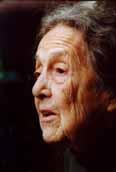Text of interview with Bernarda Shahn conducted by Bill Fernekes and Bill Marshall at Mrs. Shahn's residence, December 15, 1998.
Shahn: In order to do this job, the government was of course very interested in this town as a project for helping people in great need, as it had been, this was part of the great campaign on the part of the government, to resettle people to give them a way of life, that it was a nationwide project. They were very interested in the mural in the first place, and they said that we could do the mural if I would do it on my salary and Ben on his salary, and that they would provide all the money for the lath work and the plastering, and all the materials and we agreed we wanted to do it, and so that's how we started to do it.

Have I told you already the story about the garment workers and that they had this dream: I don't know whether I repeated that or not?
Marshall: No; go ahead and tell us that.
Shahn: The project itself was dreamed up. the actual inception of the town Roosevelt, it was originally called New Jersey Homesteads. It was with a group of garment workers who were living in the city, and this particular group happened to be highly expert workmen, and although they were highly expert in their trade, they were living in pretty bad city circumstances. And they began to cook up a dream of a factory that would be in the country and that they could all have houses in the country and that they could garden in the summertime and live decently, and so on and so forth; it was just a pipe dream. But they kept meeting and talking about it and they got so serious that their families raised $500.00 each, and one of them knew Mr. Benjamin Brown, who had set up cooperative enterprises in this country and other countries, too, and Mr. Brown knew (Harold) Ickes in Washington, so he took a delegation of the garment workers to Washington to talk to Harold Ickes, who was the Secretary of the Interior, and Mr. Ickes absolutely loved the idea instantly, because the projects had already been started under discussion and so on in the government, and so he bought it and they started to work on it.
The first architect that was hired was Tom Hibbin, if I'm not mistaken, who wanted to build this whole project with tamped earth houses, everything was experimental in those days. Tom had wanted to do it tamped earth houses, because everything was experimental in those days.Tom had wanted to do it tamped earth and they submitted all his plans and so on and never turned him down. Then the administrators, and I still think it was under Ickes at this point, thought that maybe they would just do it with prefabricated houses, so they took on a man called the Duke, he was a contractor. They built a very big factory, just on the edge of what is now the town, and they did a prefabricated number of parts of the houses and so on, and in the meantime, the Duke had made off with something like $4 million dollars worth of materials for other projects that he had, and so he was fired.
And by this time, the whole project had been turned over to Rexford Guy Tugwell, who was in the Rural Department. Tugwell called in Castner and told him what had happened, and how much money was left, and so on, and said, "Do you feel at all like doing this thing?" and Castner was dying to build a town of his own and said, "Sure, of course I would do it." So he had already started it when he suddenly go the idea that maybe Ben would like to do the mural.
So we came up here and spent the wonderful evening where everyone was singing and dancing, at this outdoor picnic. The factory building had been finished when we came up here. It was what they called a state of the art building, everything that was desirable in the clothing factory was in this building, which still stands. Now Johnny (Bernarda Shahn's son) has his studio there and various other people have places there, but it's no longer a government factory.